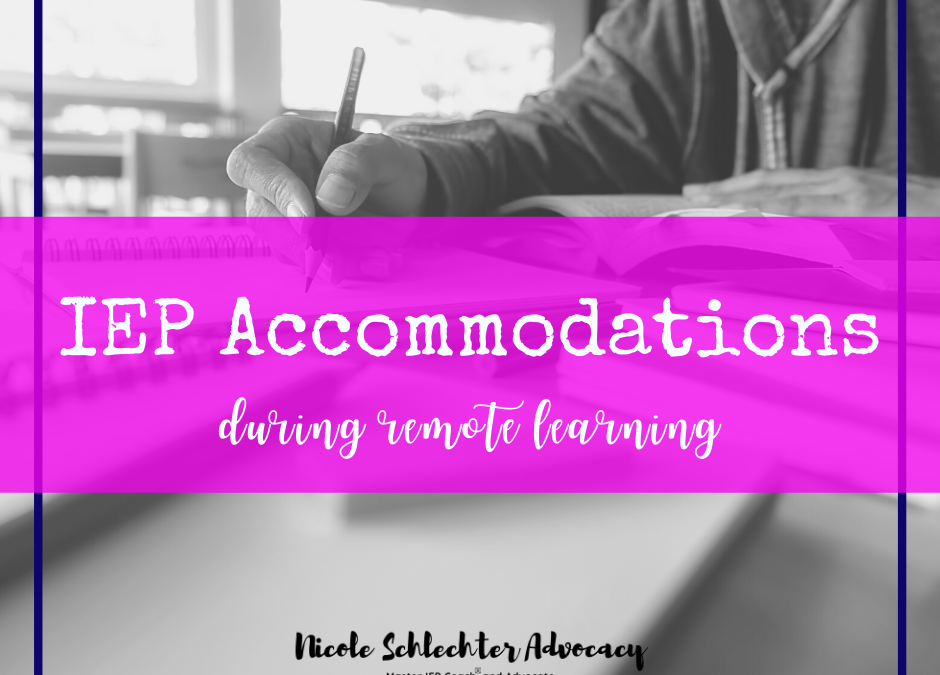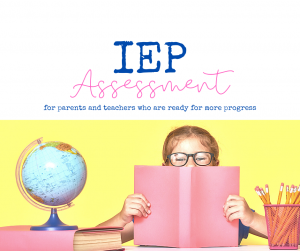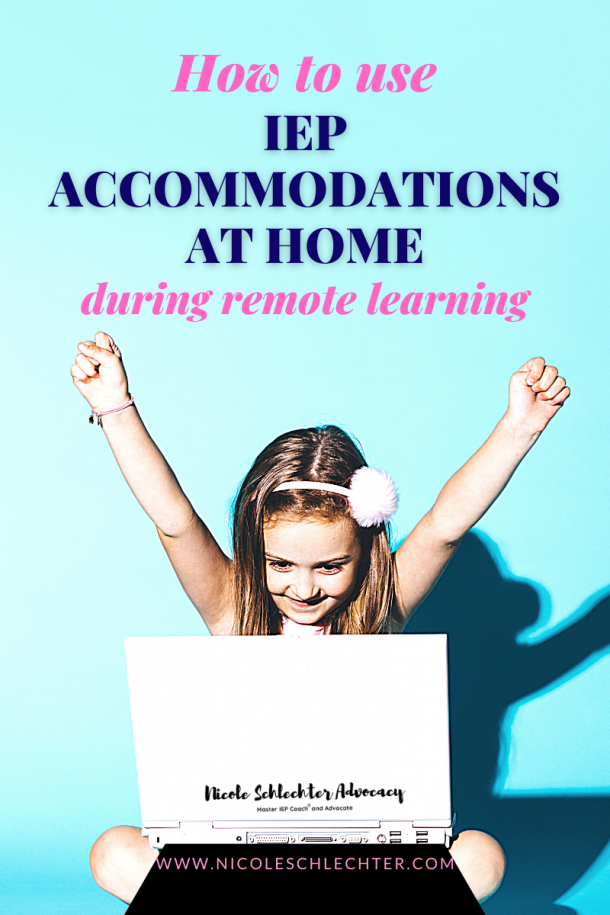(No time to read? Head to the bottom for the link to the video!)
My phone and email have been FILLED with anxious parent’s confused on how remote learning will look for their special education child. You all know, I’m not standing by letting you all feel confused and overwhelmed walking into this school year! I want to teach you about specific things you can do to CHANGE the vibe of this year for your child at school, regardless of environment.
If you have your IEP ready, let’s take a look.
What are some of the accommodations? Are they technical? For example, audio books, text-to-speech or speech-to-text software? Is your district offering chromebooks or Ipads? If not, is that in the IEP? Now, read through the accommodations… what is most important and how will we implement the accommodations at home?
If you’ve been following me, you know I’ve been talking a lot about Remote Learning Plans. I feel a little bit like a broken record, so bear with me, but if your district isn’t offering this, we should be asking for it. The IEP should not be changing. It was created for an in-class environment, however, the IEP was created to meet your child’s unique needs. Covid has not magically taught our children skills that they didn’t have before Covid. I would be willing to say in MOST cases, our children need MORE now, than they did before. Writing a remote learning plan as an addendum to the IEP, will not be excusing the school from following the plan, rather better supporting our children through a remote environment. Your IEP should not be changing, we aren’t changing goals or services necessarily, however we should be paying attention to accommodations.
For those of you who do not have chrome books or IEPs as an accommodation in your child’s IEP, do they need one?
Maybe they don’t in the classroom, but in a remote environment, they may need that type of tool to access the curriculum. However, for some of our kids, the tech isn’t appropriate for them to complete work. Maybe they need workbooks and paper packets with live zoom instruction to teach the material. We need to be paying attention to our children’s unique needs and how they learn best when they aren’t physically in a classroom.
Previously, we have talked about using this time to respect vulnerability in parents and teachers both. If you’re coming from a negative IEP table, use this time to rebuild bridges. If we can all be respectful of how difficult this time is for the other, I would be willing to bet that hard edges soften over time.
Teachers, reach out to parents and find out what worked well and what didn’t work during spring Elearning. Be mindful that most parents are not educators and may not be able to use educator language to explain what they know about their child, you may need to read through accommodations and be specific about what you are asking them.
Parent’s please know that your child’s teacher is basically thrown back into year 1 of their career and they are learning all over again. Help them by detailing what you know about your child. We all had a unique opportunity to watch our children while they are learning at home in the spring. What did you see? What was a struggle, what worked well? Have your priorities changed on what you feel is important now vs pre-covid? This doesn’t have to be pretty, bullet points are fine! But share your expertise! If you need help writing this letter to the school, reach out. I’m happy to help you get your thoughts in order.
Now let’s get specific about accommodations during remote learning.
-
Flexible seating.
What that looks like at home? The opportunity to move around as they work. Sitting on a ball instead of a chair, the choice to sit in a bean bag during homework time. Ask the team what kind of options your child is choosing at school and find a way to duplicate this option at home. Maybe it’s a stool, or doing homework standing at the counter. We aren’t trying to reinvent the wheel, use what is already working.
-
Visual Schedule.
What does that look like at home? Print out the daily schedule and expectations of learning online. If parent’s don’t have access to a printer, this may need to be mailed to them. I’m encouraging all parents to create a learning space in their homes that is not the kitchen table. A schedule should be posted in a place your student should see it easily. Make sure we are adding in breaks too!
-
Frequent breaks.
What does this look like at home? This will look similar to what it looks like at school. You will need to discuss with the team, how your child uses these breaks at school and how we can duplicate that at home. We can’t recreate an OT room at home, so what tools does the child use at school and how can we get creative with what is available at home? Does the child have access to a swing, play doh, bouncy balls, bean bags, can we create an at home fidget box? Can we create a menu of break options for home just like in school? If parents don’t have access to break favorites, how can we get them the tools they need?
-
Check in Check out.
What does this look like at home? I LOVE using this tool when I know my kiddo is really struggling to follow expectations of school or there is a change in routine. I ask the team to supply a schedule for the day. We discuss it before school and go through what the day may look like. Then we go back over it after school with LOTS of positive praise for all the areas they did well. From a school perspective, using a check in check out could be a quick zoom call. My oldest did fairly well in the spring after we figured out he needed someone to check in with him to go over assignments and expectations each day.
Some other common accommodations are allowing extra time for work, a visual planner for reminders of due date or breaking assignments up into smaller chunks.
When working with kids who are struggling with executive function or may be overwhelmed by work. We need to be mindful of how much time an assignment should take a typical student and how much time our student is actually spending. If work completion continues to be an issue and we’ve provided supports and accommodations, we may need to reevaluate what is important.
Do we need to add a modification for effort over completion?
I would rather protect a students mental health and grade the 10 problems completed rather than give an incomplete because they didn’t finish the work. Or assignments that turn into work refusal because they become too anxious to attempt it next time. A lot of this is going to fall on parents, who have other children learning from home, are working from home, may not be English speaking, may not have the best mental health themselves and are not teachers. I would love to see schools take all of that into consideration when assigning work and grading. I know that may not be reasonable in all cases but most of our kids are already struggling with social emotion behavioral deficits. Some of them have less that stellar home situations and Covid has put even more stress on that fragile situation. When we are thinking about accommodations at home, we need to be mindful of protecting the home space and our student social and emotional skills.
Speaking of social emotional, how can we support our kids at home?
-
Access to the social worker.
This is a no brainer right? Zoom calls, phone calls, drive way chats if you’re up for it. Get creative, but if your child is struggling and needs more… ask for it. Teachers, if you know home life is hard, try to team up with the social worker. If the team is unable to accommodate this type of support remotely, ask what the plan is to get back to the level of service required in the IEP? Parent’s this is important language. If services are not appropriate for your child in a virtual environment, what is the schools plan to get back to the level of service your child was receiving prior to shut down? Ask them. In writing or it didn’t happen. If you need help with the wording, reach out. I frequently team up with parents to help them write letters and beyond so their children are getting the services and support they need to be successful.
If your child has the ability to take a break in school, how does this look at home?
When possible, I like to use nonverbal communication so we are protecting students privacy. In a zoom type call, what will this look like? This could be a code word or a quick email to the teacher or using the private chat box in zoom. Teachers can use a post it system, posted on the board behind them.
Overall, most accommodations should be able to be supported at home, but will take some creativity. Need more specifics? Scroll down to grab the Masterlist of accommodations that would be appropriate for remote schooling also.
When looking over your child’s IEP, we need to be asking,
- What are the priority accommodations?
- What is a non negotiable?
All accommodations are important, and if they are in the IEP, the school should be following the plan, however, realistically in a remote environment, some accommodations may be less important than others. Once you’ve identified the priority accommodations, approach the school to find out how to make that happen.
- Who will be responsible for following up with this accommodation?
- If there is a tangible accommodation needed for example a wobble seat, kick band, fidgets or tech tools, how will we accommodate that at home?
We want to make sure the home learning environment has similar tools that your student uses at school so we stay consistent. If we know a child uses a Velcro strip on their desk at school daily, we should have that tool at school. If we know they learn best standing, how can we make that happen at home. By prioritizing the most important accommodations, we are providing consistency in all environments which will help prevent our children from regression.
This year will be different from every other year your child has had an IEP. Even if you feel like your school has been serving your child well, this year is changing everything we know about school and you don’t want your kids left behind. Now is the time to ask for a second opinion on your child’s IEP. This assessment includes:
- 30-minute consultation where we identify you goals and concerns,
- Prioritization of accommodations,
- my review of your child’s IEP,
- the exact special education language you need to use and
- at least 3 specific things you can add or change in your child’s IEP to maximize progress.
In a past life, I second guessed myself as a parent. Even though I knew my child best, I didn’t ask enough questions, I second guessed speaking up. Everything sounded good, so I let the rest of the team take the lead in my child’s education. As a result, my son was left behind at school and it took 6 months of fighting, struggling and tears for me to recognize my mistake. If you do nothing else as a parent and never need an advocate, getting an unbiased second opinion on your child’s IEP is something you don’t want to skip on. I started this career because I don’t want any other children to feel like mine felt. I don’t want another parent to look back at their child’s education and say, I wish I had asked for help sooner.



